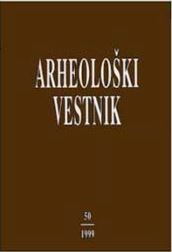Towards an archaeological appraisal of specien N° 652, from Middle-Palaeolithic Ievel D /(layer 8) of the Diivje babe l
Abstract
All examples of bones with holes from the period of the middle Paleolithic and early later Paleolithic that have been classified as flutes are discussed in this article. Evidence is offered suggesting that in fact they are not flutes. The suggested pipe from Divje Babe I is also discussed, which would belong to the same group of pseudo-artifacts. It is probably not a flute but rather a bone that was pierced by some animal.
Downloads
References
ALBRECHT, G., C.-St. HOLDERMANN, T. KERIG, J. LECHTERBECK and J. SERANGELI 1998, „Flöten“ aus Bärenknochen - die frühesten Musikinstrumente? - Arch. Korrbl. 28, 1-19.
BAYER, J. 1929, Die Olschewakultur. - Eiszeit und Urgeschichte6, 83-100, T. 5.
BRADE, Ch. 1975, Die mittelalterlichen Kernspaltflöten Mittel- und Nordeuropas. Ein Beitrag zur Überlieferung prähistorischer und zur Typologie mittelalterlicher Kern-spaltflöten. - Göttinger Schriften zur Vor- und Frühge-schichte 14.
BRADE, Ch. 1982, The Prehistoric Flute - Did it Exist? - The Galpin Society Journal 35, 138-150.
BRODAR, S. in M. BRODAR 1983, Potočka zijalka. Visokogor-ska postaja aurignacienskih lovcev (Potočka zijalka. Eine hochalpine Aurignacjägerstation). - Dela 1. razr. SAZU 24.
COLLINS, D. 1986, Palaeolithic Europe. A theotetical and system-atic study. - Devon.
FAGES, G. and C. MOURER-CHAUVIRÉ 1983, La flûte en os d ́oiseau de la grotte sépulcrale de Veyreau (Aveyron) et inven-taire des flûtes préhistoriques d ́Europe. - In: F. Poplin (ed.), La faune et l ́homme préhistorique, Mém. Soc. Préhist. Franç. 16, 95-103.
HAHN, J. and S. Münzel 1995, Knochenflöten aus dem Aurignacien des Geissenklösterle bei Blaubeuren, Alb-Donau-Kreis. - Fundber. Baden-Württ. 20, 1-12.
HOLDERMANN, C.-St. and J. SERANGELI 1998a, Flöten an Höhlenbärenknochen: Spekulationen oder Beweise? - Mitteilungsblatt der Gesellschaft für Urgeschichte 6, 7-19.
HOLDERMANN, C.-St. and J. SERANGELI 1998b, Einige Bemerkungen zur Flöte von Divje babe I (Slowenien) und deren Vergleichsfunde aus dem österreichischen Raum und angrenzenden Gebieten. - Arch. Österr. 9, 31-38.
HORUSITZKY, Z. 1955, Eine Knochenflöte aus der Höhle von Istállóskő. - Acta Arch. Acad. Sc. Hung. 5, 133-139.
KORMOS, Th. 1912, Die ersten Spuren des Urmenschen im Karstgebirge. - Földtani Közlöny. Zeitschrift der ungarischen Gesellschaft 42, 98pp.
MEGAW, J. V. S. 1960, Penny Whistles and Prehistory. - Antiquity 34, 6-13.
MOTTL, M. 1950a, Das Lieglloch im Ennstal, eine Jagdstation des Eiszeitmenschen. - Arch. Austr. 5, 18-23.
MOTTL, M. 1950b, Die paläolithischen Funde aus der Salzofen-höhle im Toten Gebirge. - Arch. Austr. 5, 24-34.
OTTE, M. 1997, On donnait des concerts dans les cavernes. - Historia / Special N° 50, Novembre-Decembre 1997, 76.
PROBST, E. 1991, Deutschland in der Steinzeit. - München.
ROTTLÄNDER, R. C. A. 1996, Frühe Flöten und die Ausbildung der musikalischen Hörgewohnheiten des paläolithischen Menschen. - In: I. Campen, J. Hahn and M. Uerpmann, Spuren der Jagd - die Jagd nach Spuren. Festschrift für Hansjürgen Müller-Beck, Tübinger Monographien zur Urgeschichte 11, 35-40.
SEEWALD, O. 1934, Beiträge zur Kenntnis der steinzeitlichen Musikinstrumente Europas. - Bücher zur Ur- und Frühgeschichte 2, Wien.
TURK, I. (ed.) 1997, Moustérienska “koščene piščal” in druge najdbe iz Divjih bab I v Sloveniji (Mousterian “bone flute” and other finds from Divje Babe I cave site in Slovenia). - Opera Instituti Archaeologici Sloveniae 2.
TURK, I., J. DIRJEC and B. KAVUR 1995, The oldest musical instrument in Europe discovered in Slovenia? - Razpr. IV. razr.
SAZU 36, 287-293.
TURK, I. and B. KAVUR 1997, Paleolitske koščene piščali - prim-erjalno gradivo (Palaeolithic bone flutes - comparable materi-al). - In: I. Turk (ed.) 1997, 179-184.
TURK, I., J. DIRJEC, G. BASTIANI, M. PFLAUM, T. LAUKO, F. CIMERMAN, F. KOSEL, J. GRUM and P. CEVC 2001, New analyses of the “flute” from Divje babe I (Slovenia). - Arh. vest. 52, 61-79.
TURK, I., J. DIRJEC and B. KAVUR 1997, Opis in razlaga nas-tanka domnevne koščene piščali (Description and explanation of the origin of the suspected bone flute). - In: I. Turk (ed.) 1997, 157-178.
Internet (Saturday, 24 October 1998):
FINK, B. 1997, Neanderthal flute, Oldest Musical Instrument’s 4 Notes, Matches 4 of Do, Re, Mi Scale (http://www.web-ster. sk.ca/greenwich/fl-compl.htm)
MARSCHAK, A. The Berekhat Ram figurine: a late Acheulian carving from the Middle East (http://intarch.ac.uk/antiq-uity/mar-shack.html)
Neanderthals Museum; Konzept: Dr. Ulrich Stodiek. Last updated: 08.13.98 (http://www.neanderthal.de and http://neander-thal. de/n_thal/fs_5.htm)
RAMANAN, K. M. 1997: Neandertals: A Cyber Perspective (http: //thunder.indstate.edu/~ramanank/art.html)
TURK, I., Dirjec, J. and Kavur B. 1996, The oldest musical instru-ment in Europe discovered in Slovenia? (htpp://www.zrc-sazu. si/www/iza/piscal.html)
WONG, K. 1997, Neanderthal Notes. Did ancient humans play mo-dern scales? In: Scientific American (http://www.sciam.com /0997issue/0997scicit4.html)
Downloads
Published
How to Cite
Issue
Section
License

This work is licensed under a Creative Commons Attribution-NonCommercial-NoDerivatives 4.0 International License.
Authors guarantee that the work is their own original creation and does not infringe any statutory or common-law copyright or any proprietary right of any third party. In case of claims by third parties, authors commit their self to defend the interests of the publisher, and shall cover any potential costs.
More in: Submission chapter





